Focaccia Recipe
This post may contain affiliate links. Read my full disclosure policy.
Learn to make focaccia, the simple Italian flatbread with its signature dimpled surface and rich olive oil flavor—it’s easier than you think!
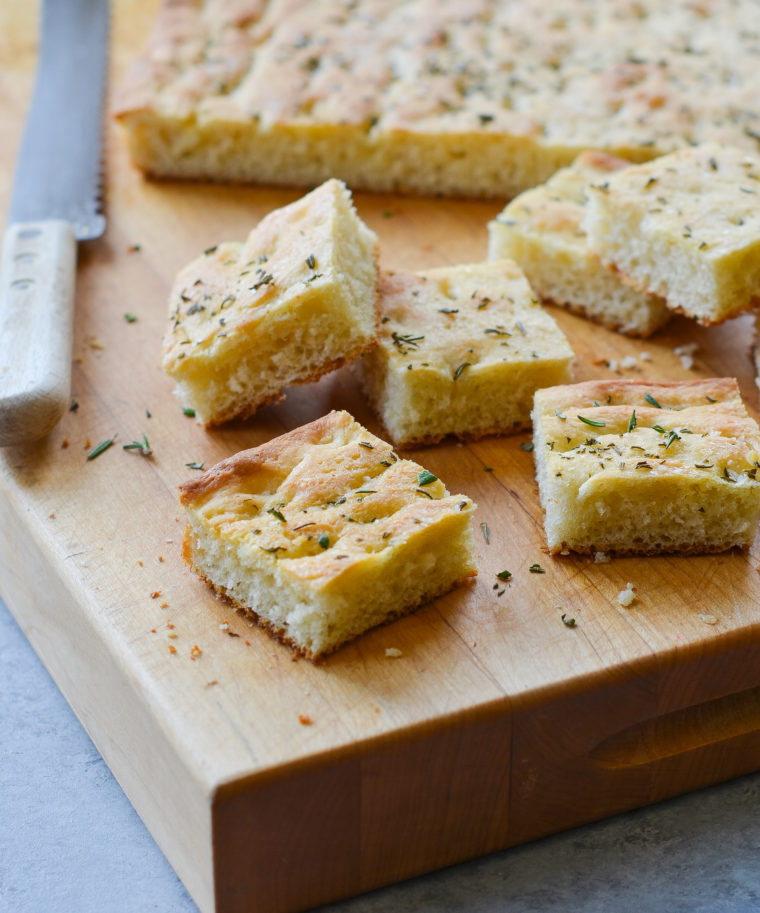
Perfect for feeding a crowd, focaccia is a rich and flavorful Italian flat bread baked in a sheet pan. It’s made with a yeast dough that rises twice: once after it is mixed and then again after it is shaped. To give the bread its signature dimpled appearance, you use your fingers to form little indentations all over the dough. These “dimples” hold tiny pools of olive oil that soak into the bread as it bakes. The recipe calls for about one cup of oil, which I know seems like a lot, but that’s what makes focaccia so good! Note that the oil is added in stages, so be sure to read the recipe carefully before starting so that you don’t accidentally add it all at once.
Adapted from Anne Burrell, this simple focaccia recipe is topped with coarse salt and fresh rosemary, but other toppings can be added, such as thinly sliced tomatoes, cherry tomatoes, olives, caramelized onions or Parmesan cheese, to name just a few. Enjoy the bread warm out of the oven with pasta fagioli, zuppa Toscana, bolognese or a big Italian salad. Leftovers make wonderful sandwiches.
“Thanks for another hit Jenn! I made this for Christmas Eve and it paired perfectly with your classic lasagna.”
What You’ll Need To Make Focaccia
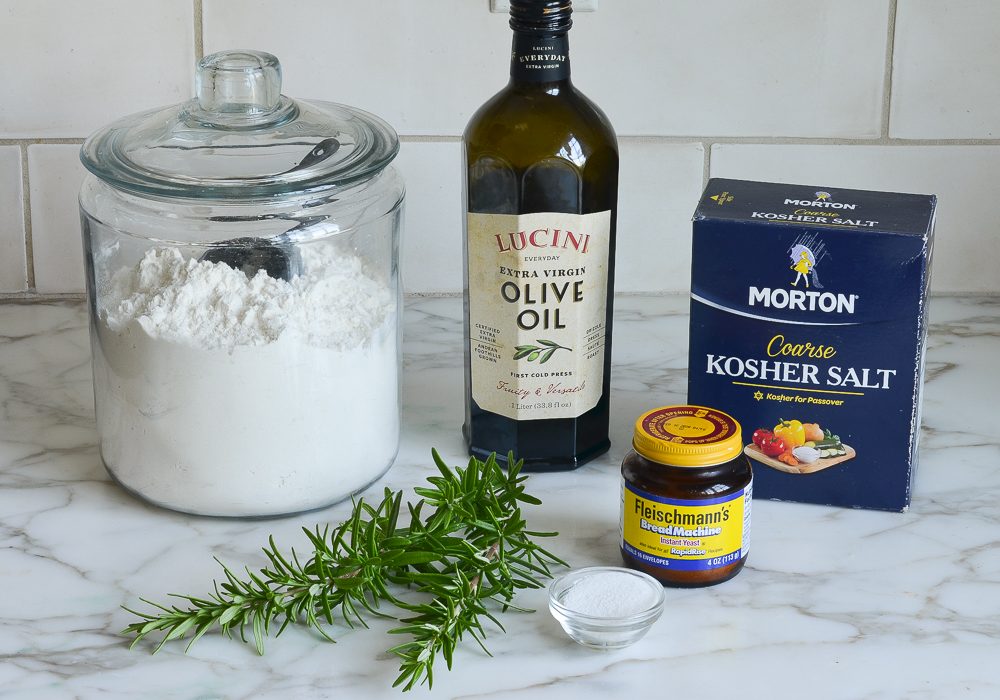
- All-purpose flour: The base of the dough. Be sure to use the spoon and level method—spoon the flour into your measuring cup and level it off with a knife—for accuracy and best results.
- Sugar: Feeds the yeast, helping the dough rise.
- Yeast: Makes the bread rise. I use instant or rapid-rise yeast (sometimes labeled “bread machine yeast”) for focaccia and other yeast breads because it rises much faster than active dry yeast. You can find it in jars or packets, and once opened, it keeps in the fridge for 3 to 6 months. If you don’t bake homemade breads often, I recommend buying the individual packets to ensure freshness.
- Kosher salt: Adds flavor to both the dough and the top of the focaccia.
- Warm water: Activates the yeast and brings the dough together.
- Extra-Virgin Olive oil: Provides richness and flavor while also creating a crispy bottom.
- Fresh rosemary: Adds an earthy, fragrant flavor. Feel free to experiment with other herbs like thyme or oregano for a different twist.
- Jump to the printable recipe for precise measurements
Step-By-Step Instructions
Step 1: Make the Dough
Begin by combining the flour, salt, sugar, and yeast in the bowl of a heavy-duty mixer fitted with the dough hook.
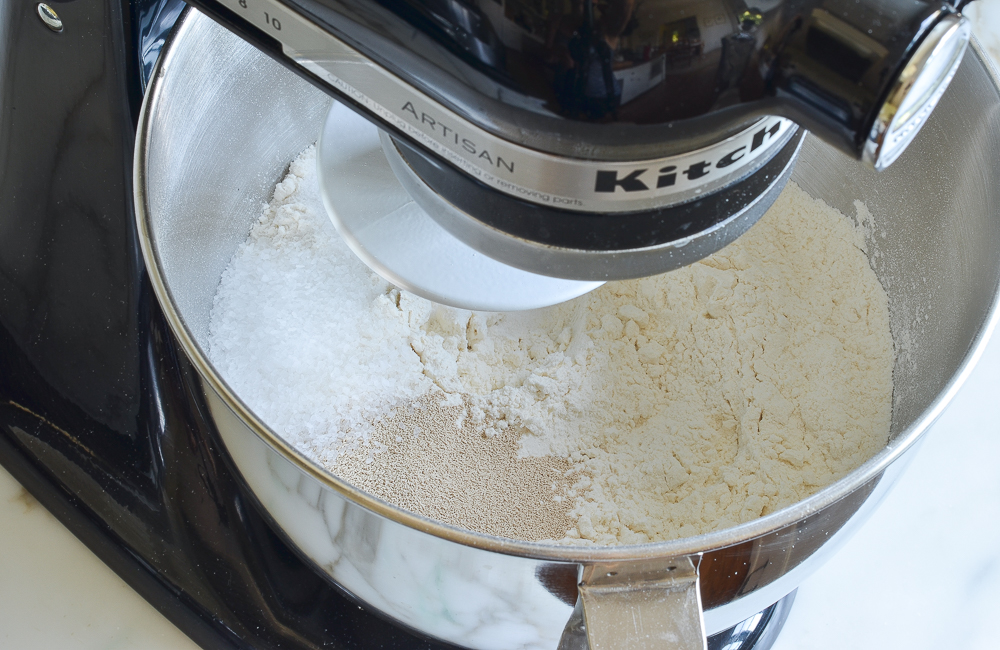
Mix to combine.
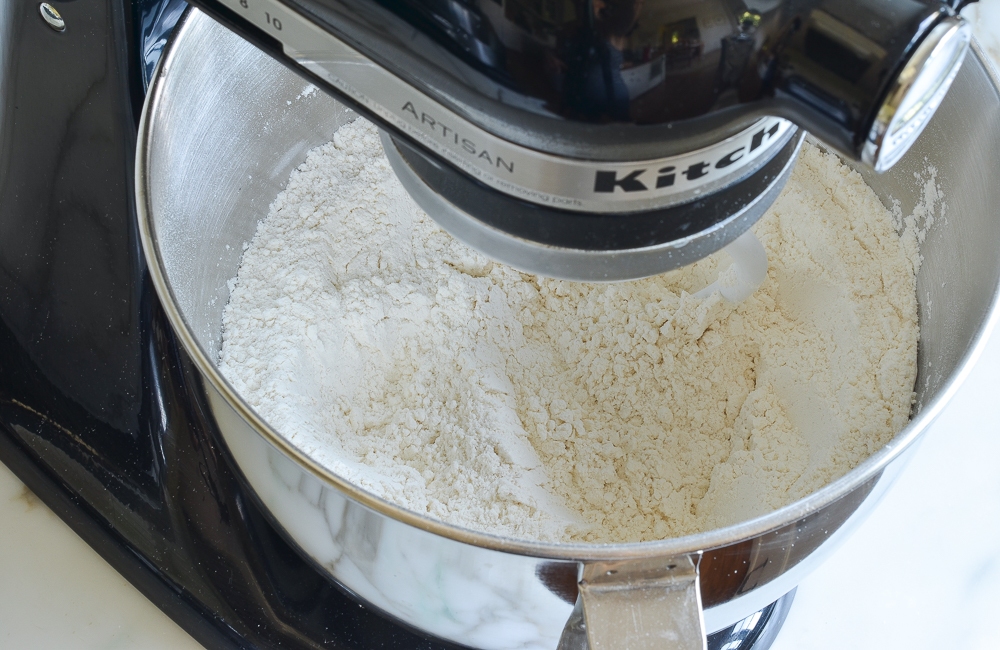
Add 1-3/4 cups warm water and 1/2 cup of the olive oil.
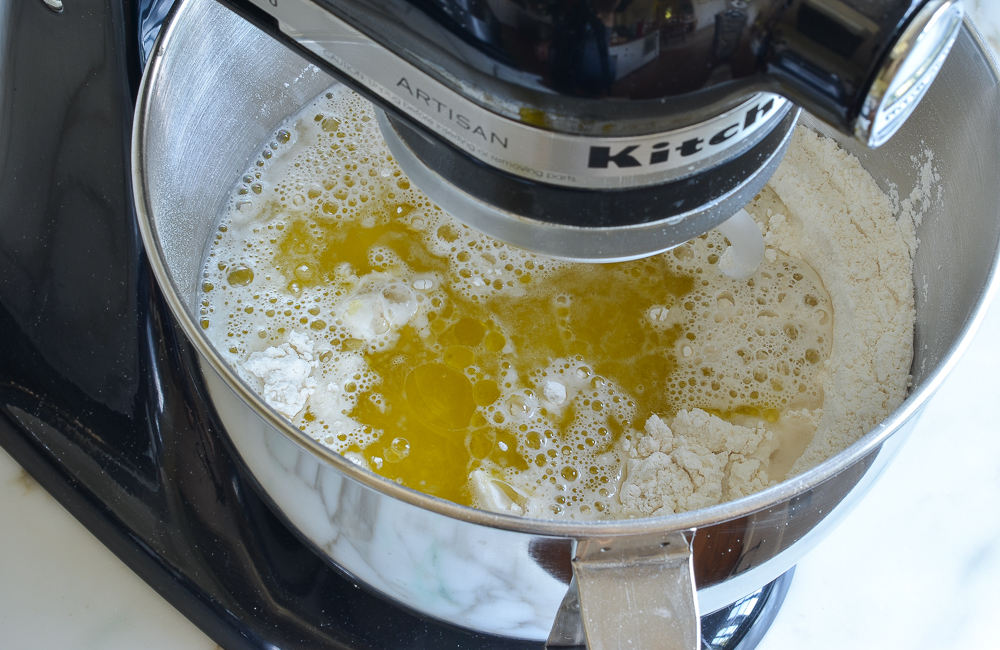
Mix on low speed until the dough comes together into a sticky mass.
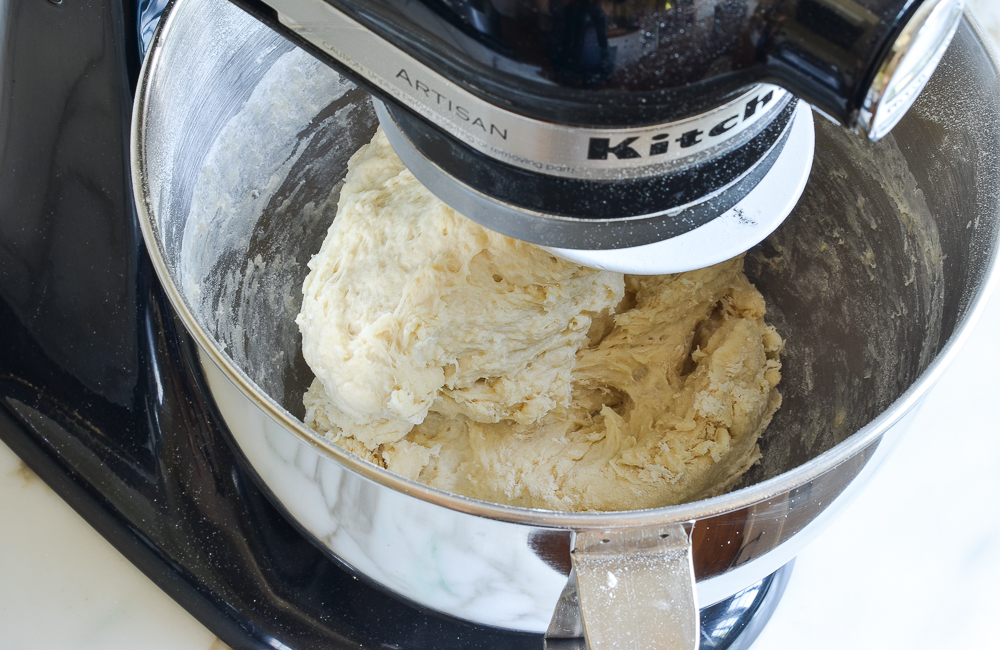
Increase the speed to medium and knead for 5 to 6 minutes, or until the dough becomes soft and slightly tacky. It should stick to the bottom of the bowl a bit. If the dough seems too wet, sprinkle with a few tablespoons of flour, and turn the mixer back on to knead it briefly to combine.
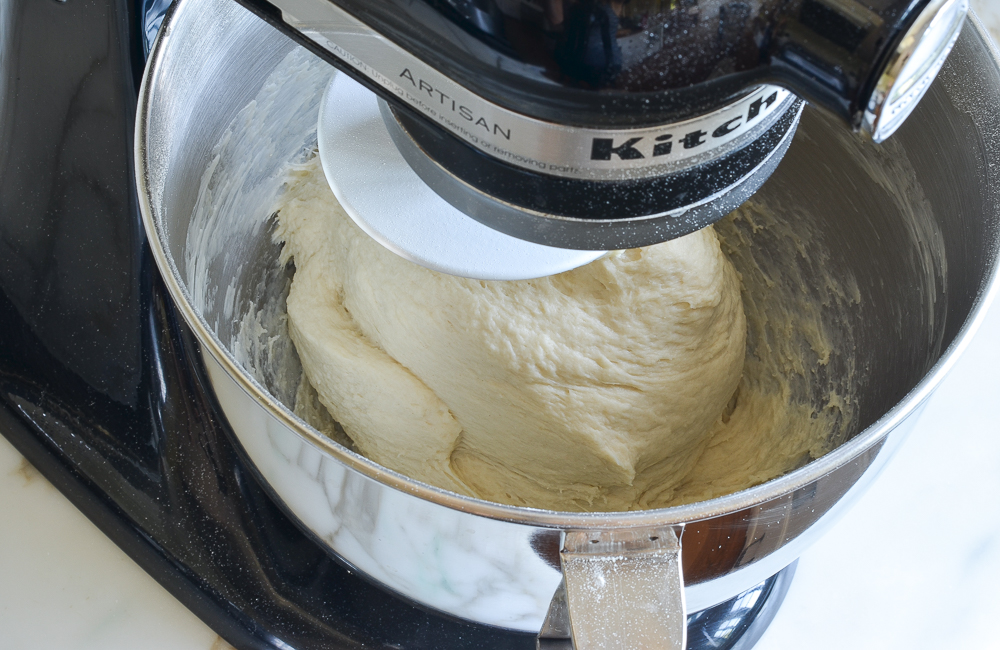
Transfer the dough to a lightly floured surface.
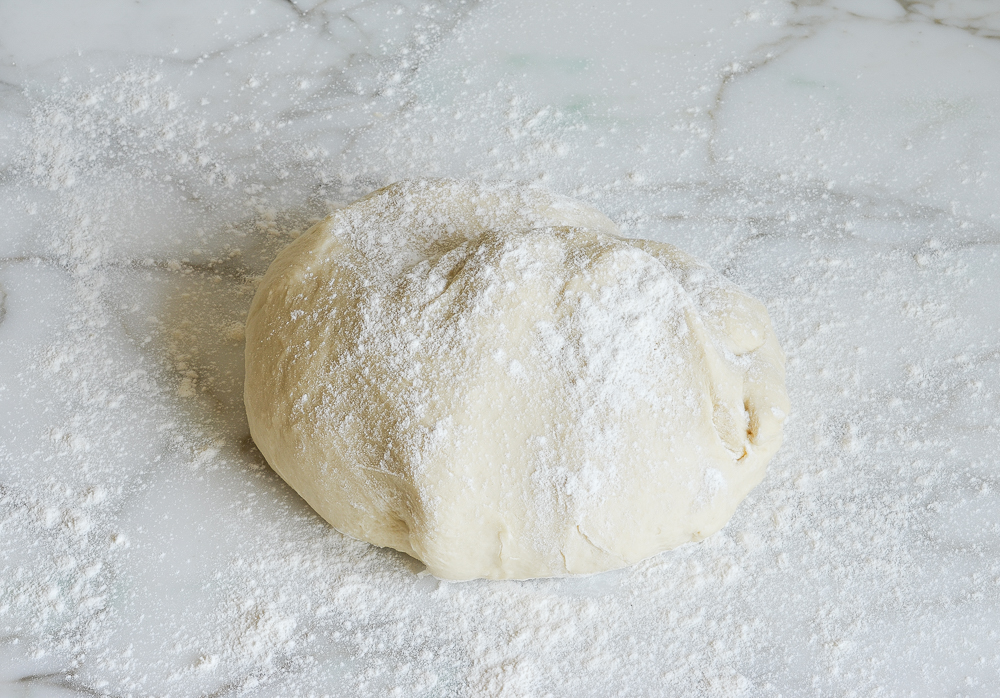 Briefly knead with your hands until it comes together into a smooth ball.
Briefly knead with your hands until it comes together into a smooth ball.
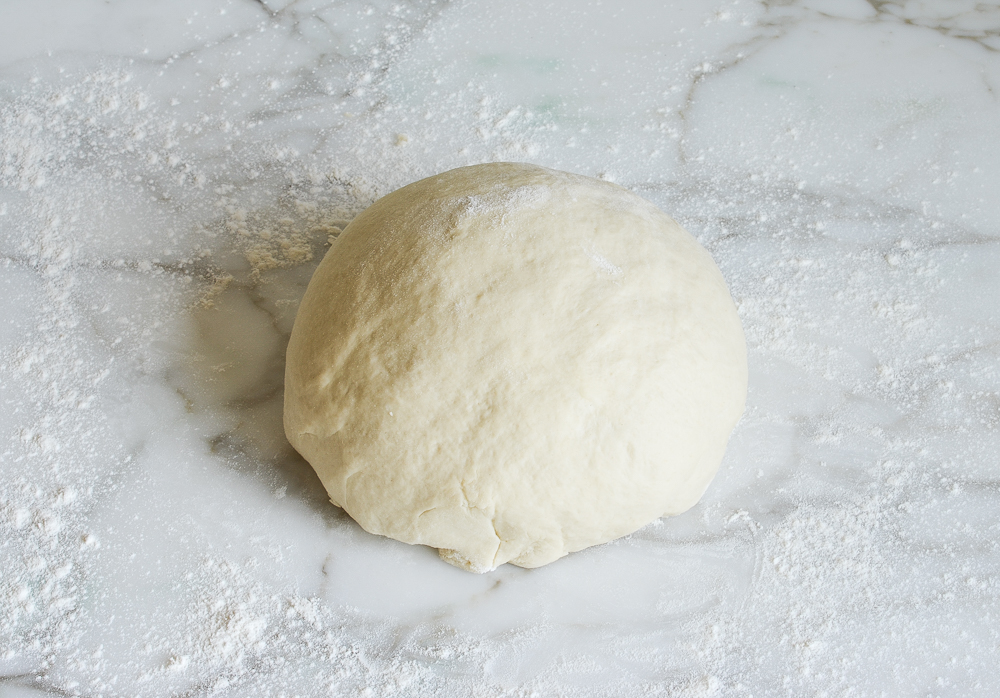
Step 2: Let the Dough Rise
Place the dough in a large greased bowl, flipping it over once so that both the top and bottom of the dough are lightly slicked with oil.
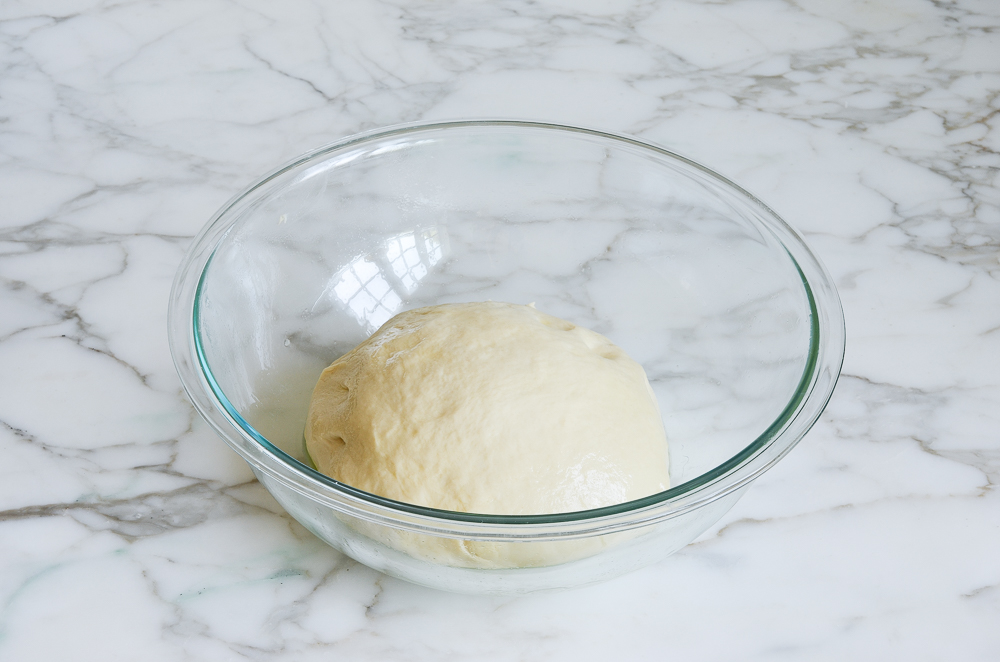
Let it rise in a warm, draft-free spot until doubled in size, 1 to 2 hours.
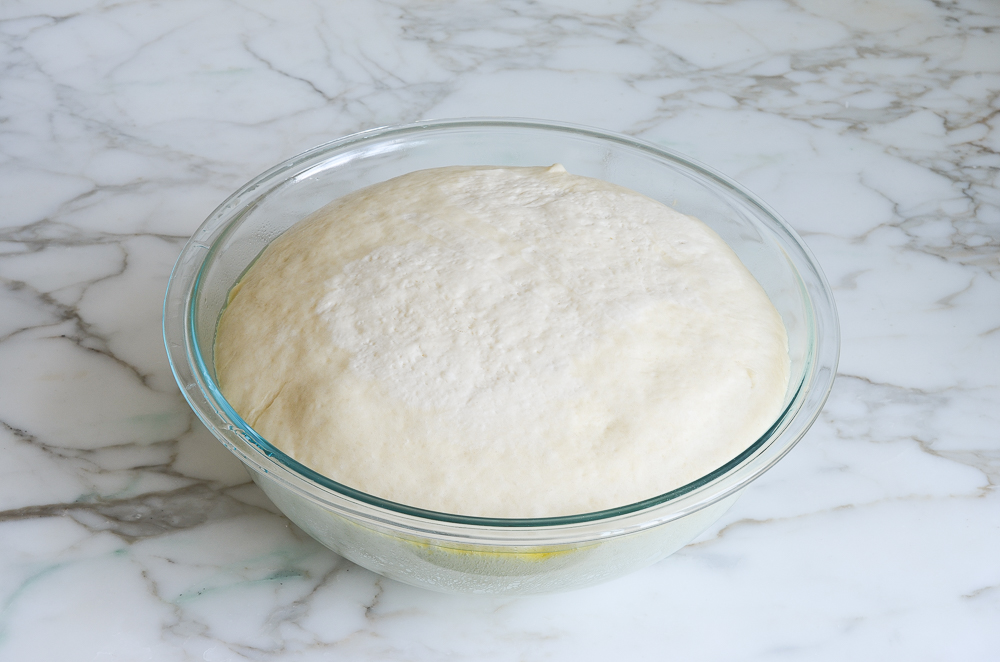
Step 3: Shape the Dough and Let Rise Again
Pour about 1/4 cup olive oil onto a 13″ x 18″ rimmed baking sheet (I know it seems like a lot, but that’s what gives focaccia its characteristic crispy bottom), then place the dough on top.
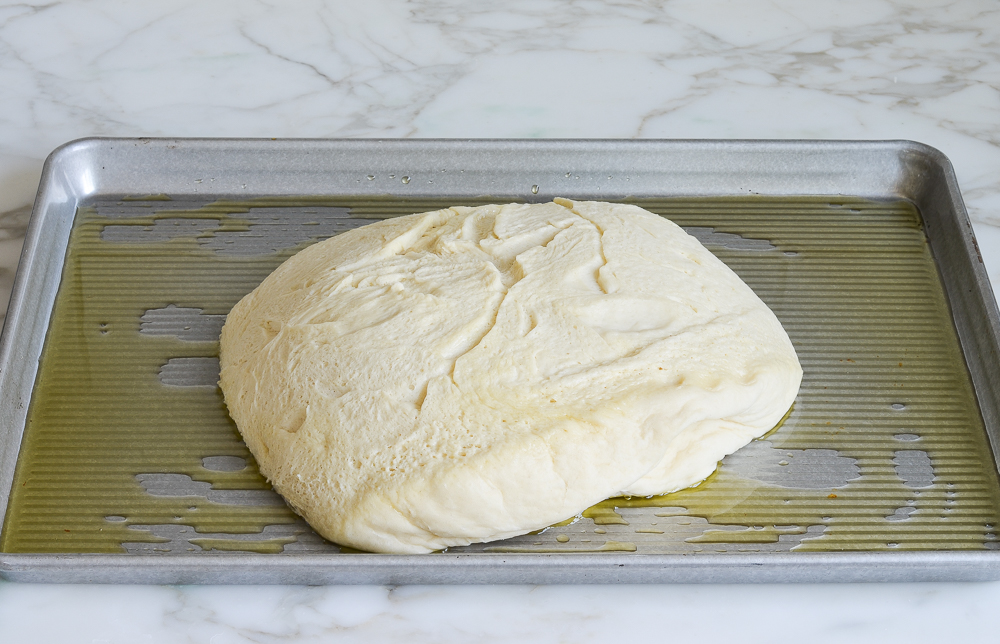
Flip it over once so that both sides are coated with oil; this makes it easier to stretch. Using your hands, spread it out to the corners of the pan.
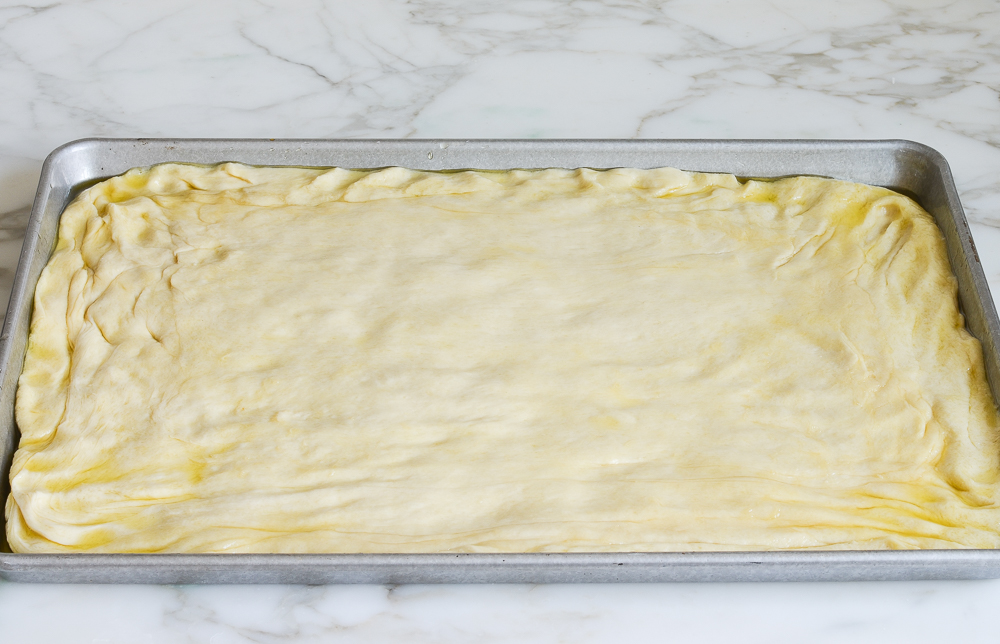
Use your fingertips to make dimples all over the dough.
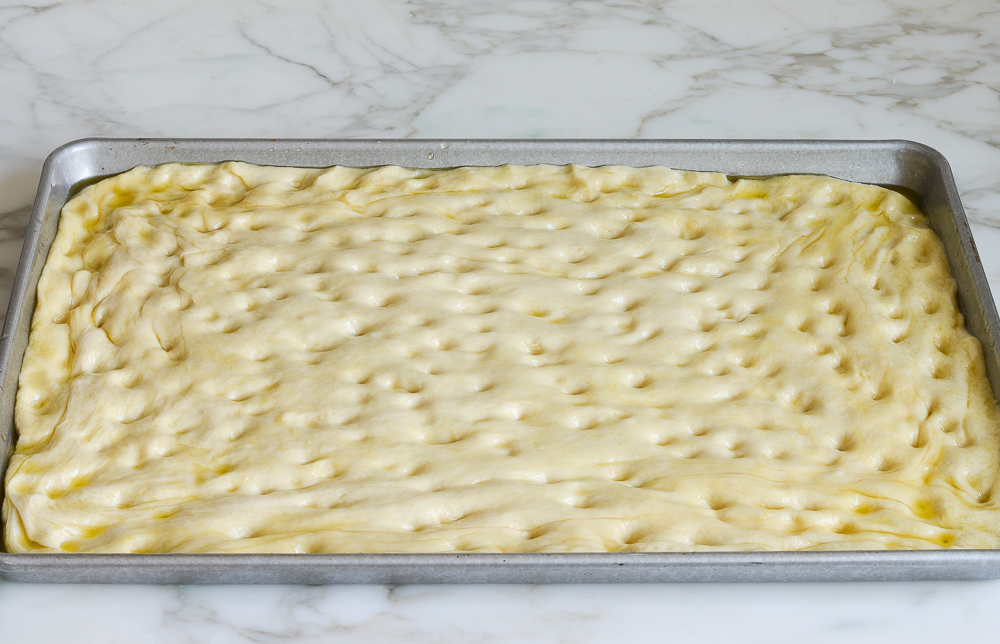
Cover the pan with plastic wrap and let the dough rise again a warm spot until puffed up and doubled in size, about an hour. Drizzle the dough with a bit of olive oil, so it pools in the dimples, and sprinkle with 3/4 teaspoon kosher salt and fresh rosemary.
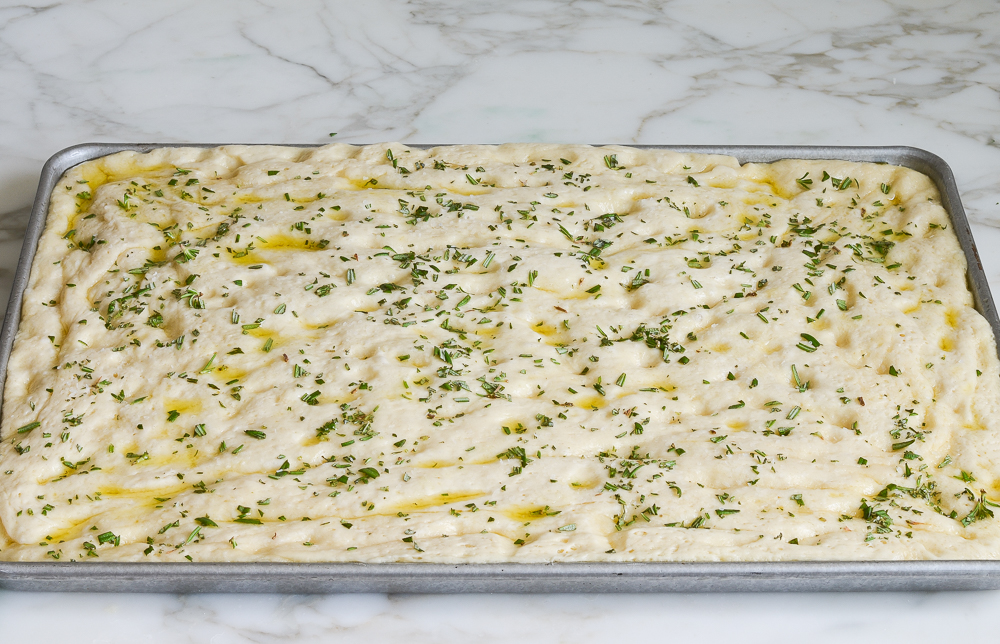
Step 4: Bake
Bake for about 20 minutes, until golden.
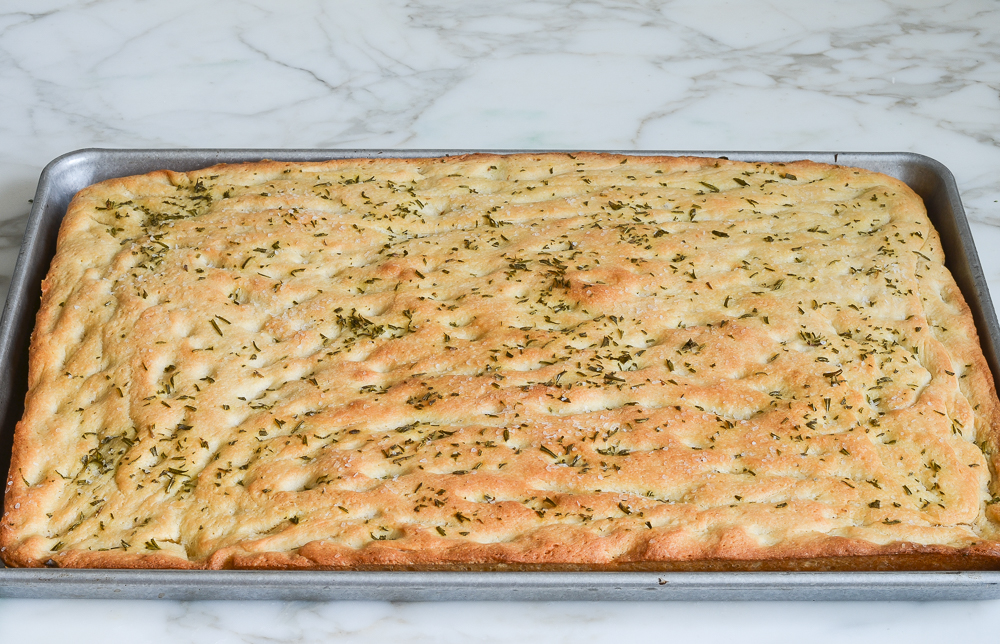
Let cool for about 15 minutes, then transfer to cutting board and slice into squares. Drizzle with a touch more olive oil if desired.
Freezing Instructions
The homemade focaccia bread recipe freezes beautifully. To freeze, cut it into portions, wrap in plastic wrap and then foil and freeze for up to 3 months. To reheat the focaccia, remove the plastic wrap and rewrap it in the foil. Heat it in a 350-degree oven for 10 minutes or until heated through.
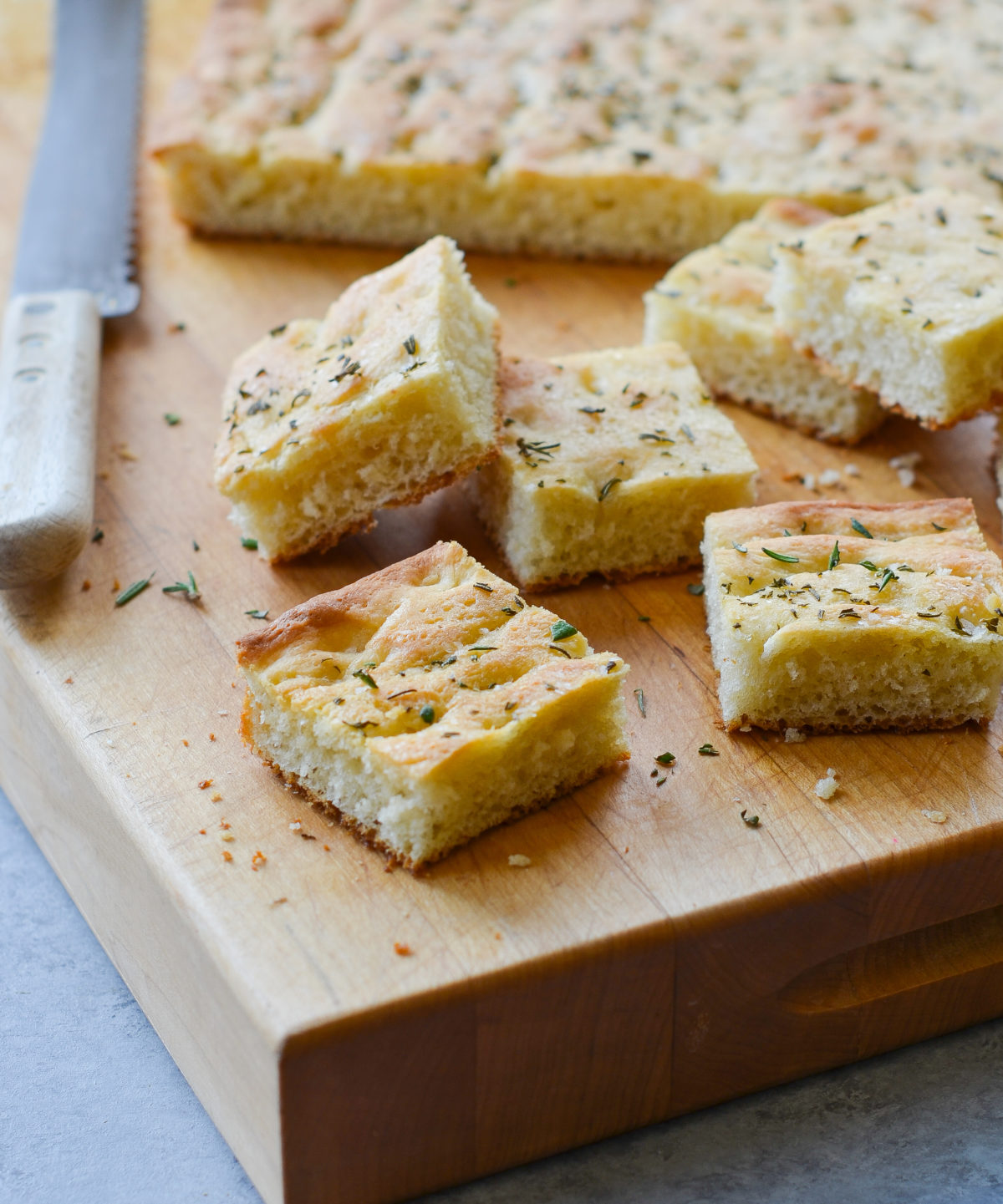
You May Also Like
Focaccia
Learn to make focaccia, the simple Italian flatbread with its signature dimpled surface and rich olive oil flavor—it’s easier than you think!
Ingredients
- 5 cups all-purpose flour, spooned into measuring cup and leveled-off with a knife, plus more for kneading
- 1 tablespoon sugar
- 1 packet (2¼ teaspoons) instant/rapid-rise yeast (see note)
- 1 tablespoon + ¾ teaspoon kosher salt, divided
- 1¾ cup warm water
- ¾ cup extra virgin olive oil, divided, plus more for oiling the bowl and drizzling on top
- 1 tablespoon chopped fresh rosemary, from several sprigs
Instructions
- In the bowl of a mixer fitted with a dough hook, combine the flour, sugar, yeast, and 1 tablespoon of the salt. Mix on low speed to combine. Add the water and ½ cup of the olive oil; mix on low speed until the dough comes together, then turn the speed up to medium-low and continue to knead for 5 to 6 minutes, until the dough becomes soft and slightly tacky. It should stick to the bottom of the bowl a bit. If the dough seems too wet, sprinkle with a few tablespoons of flour, and turn the mixer back on to knead it briefly to combine.
- Transfer the dough to a clean, lightly floured surface (it helps to flour your hands, too). Knead by hand briefly until the dough comes together into a smooth ball.
- Coat the inside of a large bowl with about 1 teaspoon of olive oil. Place the dough in the bowl, flipping once so that both the top and bottom are lightly slicked with oil. Cover the bowl with plastic wrap and put it in a warm, draft-free spot until the dough has doubled in size, 1 to 2 hours. (The warmer the spot, the faster it will rise.)
- Coat a 13" x 18" rimmed baking sheet with ¼ cup of olive oil. (It will seem like a lot, but that's what makes the bottom crispy.) Plop the dough onto the prepared pan and begin pressing it out with your hands to fit the size of the pan. Turn the dough over once to coat both sides with olive oil. Continue to stretch the dough to fit the pan. Once the dough is stretched, spread your fingers out and make impressions almost all the way through the dough (don't poke holes, just press down to the bottom of the pan). Cover the pan with plastic wrap and place in the warm, draft-free spot until the dough has puffed up and doubled in size, about 1 hour.
- While the dough is rising a second time, preheat the oven to 425°F. Set an oven rack in the middle position.
- Sprinkle the top of the focaccia dough with the remaining ¾ teaspoon kosher salt and rosemary, then lightly drizzle about 1 tablespoon of olive oil on top so it pools in the indentations. Bake until golden brown, about 20 minutes. Remove the focaccia from the oven and let it cool in the pan on a wire rack for about 15 minutes. Transfer the focaccia to a cutting board and slice into squares. Drizzle a touch more oil on top before serving, if desired.
- Make-Ahead/Freezer-Friendly Instructions: Focaccia is best eaten freshly baked but it can be made 1 day ahead of time, if necessary. For best results, wrap the focaccia in aluminum foil and place in a sealed plastic bag at room temperature. Reheat, wrapped in foil, in a 350°F oven until just warmed through, about 10 minutes. The focaccia can also be made ahead and frozen. To freeze, cut it into portions, wrap in plastic wrap and then foil and freeze for up to 3 months. To reheat the focaccia, remove the plastic wrap and re-wrap it in the foil. Heat it in a 350°F oven for 10 minutes or until heated through.
- Note: Active dry yeast may be used instead of instant/rapid-rise yeast, however, the dough will take longer to rise. To give active dry yeast a boost, you can add it to the warm water in the recipe, let it sit until frothy, about 10 minutes, and then proceed with the recipe.
Nutrition Information
Powered by ![]()
- Serving size: 2 squares
- Calories: 325
- Fat: 15 g
- Saturated fat: 2 g
- Carbohydrates: 41 g
- Sugar: 1 g
- Fiber: 2 g
- Protein: 6 g
- Sodium: 160 mg
- Cholesterol: 0 g
This website is written and produced for informational purposes only. I am not a certified nutritionist and the nutritional data on this site has not been evaluated or approved by a nutritionist or the Food and Drug Administration. Nutritional information is offered as a courtesy and should not be construed as a guarantee. The data is calculated through an online nutritional calculator, Edamam.com. Although I do my best to provide accurate nutritional information, these figures should be considered estimates only. Varying factors such as product types or brands purchased, natural fluctuations in fresh produce, and the way ingredients are processed change the effective nutritional information in any given recipe. Furthermore, different online calculators provide different results depending on their own nutrition fact sources and algorithms. To obtain the most accurate nutritional information in a given recipe, you should calculate the nutritional information with the actual ingredients used in your recipe, using your preferred nutrition calculator.

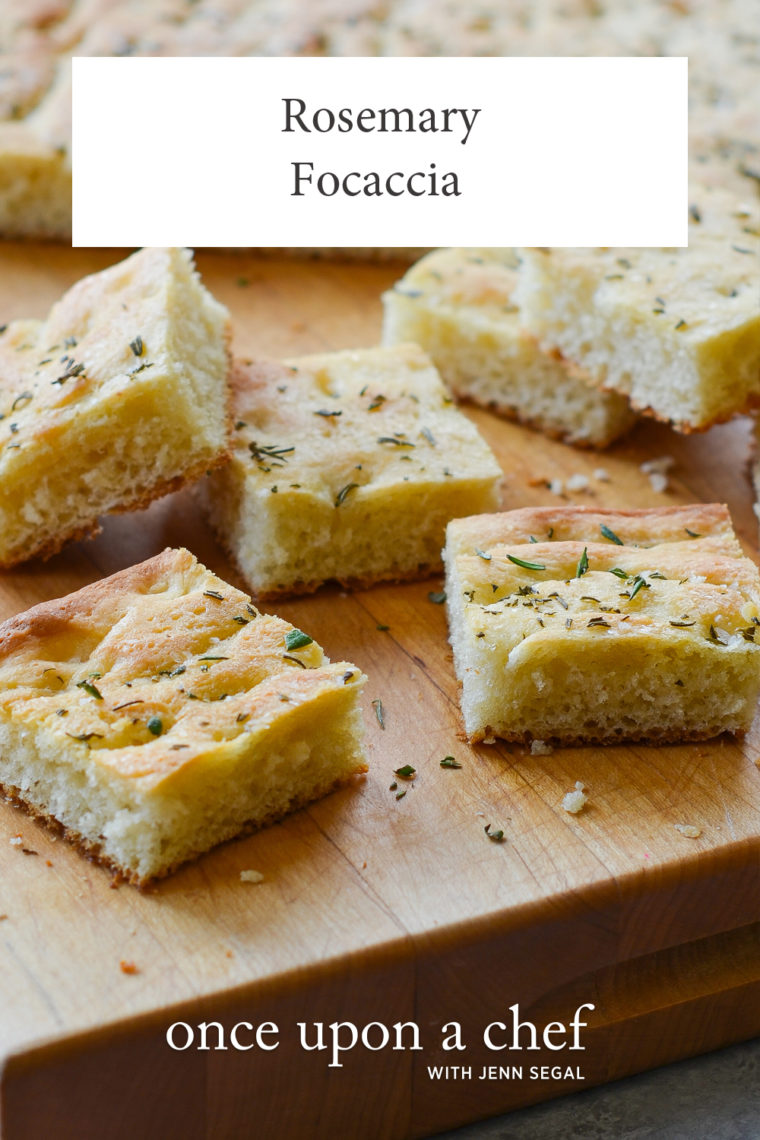
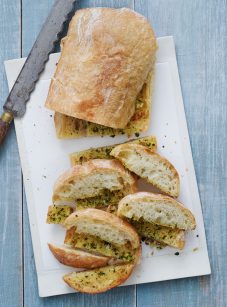
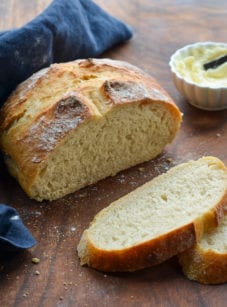
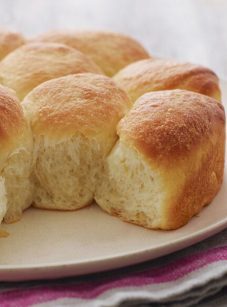
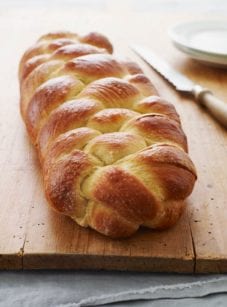
This turned out great even though I made a huge error by forgetting to put in the 3/4 C olive oil until after I had kneaded the dough! I figured it would be hard as a rock! However, it turned out fine. Just delicious. That’s my kind of recipe! Foolproof. Lesson learned though. Next time I’ll do it right!
Jenn,
I am going to make this again after having the focaccia stick to the pan the first time. I didn’t remove the focaccia as directed and sadly the entire piece of bread was glued to the pan. It’s been a few years since I made it but I’m certain I would have used all the oil you recommend. Do you think letting the focaccia completely cool in the pan was the problem? I want to make it again.
Hi Kerrie, I’m sorry to hear you had a problem with this sticking to the pan the last time you made it! With the amount of oil, it really shouldn’t stick, so it could be that letting it cool completely in the pan may have caused the issue. Also, before making it again, if your baking sheet is really old, it may have lost some of its nonstick quality so it may be time to purchase a new one. Hope that helps and you have better luck this time around!
Hello there! I know this is kinda off topic but I’d figured I’d ask. Would you be interested in exchanging links or maybe guest authoring a blog article or vice-versa? My blog goes over a lot of the same topics as yours and I feel we could greatly benefit from each other. If you are interested feel free to shoot me an email. I look forward to hearing from you! Fantastic blog by the way!
Hi Delicia, Thanks for inquiring! As much as I appreciate the offer, I don’t really have any outside content on the blog and am in not in the practice of writing for other blogs. Thanks again though! 🙂
Can gluten free flour be used?
Hi Kirsten, I haven’t made this with gluten-free flour, so I can’t say for sure. (Oftentimes, readers will comment that they’ve adapted my baked goods to be gluten-free, but I don’t see any comments mentioning that here, so you’d be the “guinea pig.”) If you want to give it a try I know a lot of readers have had great luck with King Arthur’s gluten-free flour. Please LMK how it turns out if you try it!
Hi Kirsten! Did you end up trying to make this GF? I’d love to hear how it turned out. My one daughter is celiac and misses good bread.
This was delicious. I do not have a mixer with a dough hook so I used a food processor to mix the dough and then kneaded it by hand. Other than that I followed the recipe exactly as written. It came out really well. Everyone loved it! I will definitely make this again.
Hi Jenn! I just made your rosemary focaccia and it was delicious :). I am planning to freeze the remaining half. When I want to serve it, do I wrap the frozen focaccia in foil and heat it directly from the freezer or do I need to let it thaw before wrapping it in the foil and baking it? Thank you so much!
Glad you like it! You can put it into the oven directly from the freezer; no need to thaw.
Yummm!
This is just about the easiest bread I have ever made. It is quick, easy and delicious.
My family likes it with a little grated garlic added with the rosemary and a little Romano cheese added during the last 5 minutes of baking. I have also served it with olive oil and balsamic vinegar to dip in – Wow!
I don’t have a rimmed baking sheet, will that be a problem?
Yes, you really need the rim here or there’s nothing to contain the olive oil.
Your recipes are truly the best! I always cook with confidence bc of you, so thank you very much! ❤️Question: I make your focaccia bread and love it. I want to be able to finish making the bread where I can bake it right before we eat. How far in advance can the dough sit waiting to be baked? Thanks!
So glad you like the recipes, Vicky! You can get away with letting the dough sit for up to 90 minutes for the second rise, but I wouldn’t let it go longer than that. Hope that helps and that you enjoy!
Awesome recipe. Very easy to follow your step by step instructions, which I found makes it fool proof. I’ve made this focaccia three times in the past two months, and each time I made it, it came out better then the last. My family really loves it. I’ve used it to make grilled vegetable sandwiches, alternating with a thin slice of mozzarella and speck prosciutto. Also, another time in place of rosemary, I used caramelized onions, herb de provenance mixture, and sprinkled with a little sea salt. I think the possibilities are endless. Great appetizer.